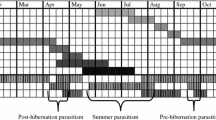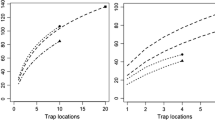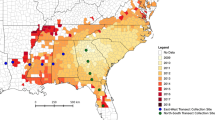Abstract
The extent of within-patch dispersal by a tephritid fly and its four major parasitoids was examined over three field seasons. Hosts and parasitoids were marked using acrylic paint and observed as they oviposited into the flowerheads of marsh thistle, Cirsium palustre. The average recapture rate pooled across all species was 22%. The four parasitoids showed consistently greater rates of movement than the host in all three years. In nearly all comparisons, male dispersal was less than female dispersal. There was no evidence that parasitoids moved longer distances after visiting low quality rather than high quality patches. In the one season it was studied, no correlations between movement and insect size were observed. The relevance of these observations to host-parasitoid population dynamics is discussed.
Similar content being viewed by others
References
Andersen RC, Paschke JD (1970) Factors affecting the post-release dispersal of Anaphes flavipes (Hymenoptera: Mymaridae), with notes on its postrelease development, efficiency, and emergence. Ann Entomol Soc Am 63: 820–828
Andow DA, Kareiva PM, Levin SA, Okubo A (1990) Spread of invading organisms. Landscape Ecol 4: 177–188
Askew RR (1968) A survey of leafminers and their parasites on laburnum. Trans R Entomol Soc Lond 120: 1–37
Bressan S, Teles MC da, Costa-Teles M da (1991) Recapture of marked adults of Anastrepha spp. (Diptera: Tephritidae) released at one point of an orchard (in Spanish). Rev Bras Entomol 35: 679–684
Chesson PL, Murdoch WW (1986) Aggregation of risk: relationships among host-parasitoid models. Am Nat 127: 696–715
Comins HN, Hassell MP, May RM (1992) The spatial dynamics of host-parasitoid systems. J Anim Ecol 61: 735–748
Copland MJW, Askew RR (1977) An analysis of the chalcidoid (Hymenoptera) fauna-of a sand-dune system. Ecol Entomol 2: 27–46
DeBach P (1974) Biological control by natural enemies. Cambridge University Press, Cambridge
DeBach P, Argyriou LC (1967) The colonization and success in Greece of some important Aphytis spp. (Hym. Aphelinidae) parasitic on citrus scale insects (Hom. Diaspidae). Entomophaga 12: 325–342
Dempster JP, Atkinson DA, French MC (1995) The spatial dynamics of insects exploiting a patchy food resource. II. Movements between patches. Oecologia 104: 354–362
Driessen G, Hemerik L (1992) The time and egg budget of Leptopilina clavipes, a parasitoid of larval Drosophila. Ecol Entomol 17: 17–27
Eber S, Brandl R (1994) Ecological and genetic spatial patterns of Urophora cardui (Diptera: Tephritidae) as evidence for population structure and biogeographical processes. J Anim Ecol 63: 187–199
Godfray HCJ (1994) Parasitoids. Behavioural and evolutionary ecology. Princeton University Press, Princeton
Godfray HCJ, Pacala SW (1992) Aggregation and the population dynamics of parasitoids and predators. Am Nat 140: 30–40
Godfray HCJ Agassiz DJ, Nash DR, Lawton JH (1995) The recruitment of parasitoid species to two invading herbivores. J Anim Ecol 64: 393–402
Hassell MP (1978) The dynamics of arthropod predator-prey systems. Princeton University Press, Princeton
Hassell MP, May RM (1973) Stability in insect host-parasite models. J Anim Ecol 42: 693–726
Hassell MP, May RM (1974) Aggregation in predators and insect parasites and its effect on stability. J Anim Ecol 43: 567–594
Hassell MP, May RM, Pacala S, Chesson PL (1991a) The persistence of host-parasitoid associations in patchy environments. I. A general criterion. Am Nat 138: 568–583
Hassell MP, Comins HN, May RM (1991b) Spatial structure and chaos in insect population dynamics. Nature 353: 255–258
Hassell MP, Comins HN, May RM (1994) Species coexistence via self-organizing spatial dynamics. Nature 370: 290–292
Hendrichs J, Katsoyannos BI, Papaj DR, Prokopy RJ (1991) Sex differences in movement between natural feeding and mating sites and tradeoffs between food consumption, mating success and predator evasion in Mediterranean fruit flies (Diptera, Tephritidae). Oecologia 86: 223–231
Hendricks DE (1967) Effects of wind on dispersal of Trichogramma semifumatum. J Econ Entomol 60: 1367–1373
Hopper KR, Woolson EA (1991) Labelling a parasitic wasp, Microplitus croceipes (Hymenoptera, Braconidae) with trace elements for mark recapture studies. Ann Entomol Soc Am 84: 255–262
Hurlbutt BL (1987) Sexual size dimorphism in parasitoid wasps. Biol J Linn Soc 30: 63–89
Ives AR (1992) Continuous-time models of host-parasitoid interactions. Am Nat 140: 1–29
Jackson CG, Cohen AC, Verdugo CL (1988) Labelling Anaphes ovijentatis (Hymenoptera, Mymaridae), an egg parasite of Lygus spp. (Hemiptera, Miridae). Ann Entomol Soc Am 81: 919–922
May RM (1978) Host-parasitoid systems in patchy environments: a phenomenological model. J Anim Ecol 47: 833–843
Messing RH, Klungness LM, Purcell MF (1994) Short-range dispersal of mass-reared Diachasimorpha longicaudata and D. tryoni (Hymenoptera, Braconidae), parasitoids of tephritid fruit flies. J Econ Entomol 87: 975–985
Murdoch WW, Stewart-Oaten A (1989) Aggregation by parasitoids and predators: effects on equilibrium and stability. Am Nat 134: 288–310
Murdoch WW, Briggs CJ, Nisbet RM, Gurney WSC, Stewart-Oaten A (1992) Aggregation and stability in metapopulation models. Am Nat 140: 41–58
Nash DR, Agassiz DJL, Godfray HCJ, Lawton JH (1995) The pattern of spread of invading species: two leaf-mining moths colonizing Great Britain. J Anim Ecol 64: 225–233
Onillon JC (1990) The use of natural enemies for the biological control of whiteflies. In: Gerling D (ed) Whiteflies: their bionomics, pest status and management. Intercept, Andover, Hampshire, pp 287–314
Papaj DR, Vet LEM (1990) Odor learning and foraging success in the parasitoid, Leptopilina heterotoma. J Chem Ecol 16: 3137–3150
Payne JA, Wood BW (1984) Rubidium as a marking agent for the hickory shuckworm (Cydia caryari) (Lepidoptera, Tortricidae). Environ Entomol 13: 1519–1521
Richards OW, Waloff N (1954) Studies on the biology and population dynamics of British grasshoppers. Anti-Locust Bull 17: 1–182
Rivero-Lynch AP, Jones TH (1993) The choice of oviposition site by Terellia ruficauda on Cirisum palustre. Acta Oecol 14: 643–651
Rohani P, Godfray HCJ, Hassell MP (1994) Aggregation and the dynamics of host-parasitoid systems: a discrete-generation model with within-generation redistribution. Am Nat 144: 491–509
Schlumprecht H (1989) Dispersal of thistle gallfly, Urophora cardui and its endoparasitoid Eurytoma serratulae (Hymenoptera: Eurytomidae). Ecol Entomol 14: 341–348
Sonleitner FJ, Bateman MA (1963) Mark-recapture analysis of a population of Queensland fruit-fly, Dacus tryoni (Frogg.) in an orchard. J Anim Ecol 32: 259–269
Stern VM, Schlinger EI, Brown WR (1965) Dispersal studies of Trichogramma semifumatum (Hymenoptera: Trichogrammatidae) tagged with radioactive phosphorous. Ann Entomol Soc Am 58: 234–240
Varley GC (1947) The natural control of population balance in the knapweed gall-fly (Urophora jaceana). J Anim Ecol 16: 139–187
Varley GC, Gradwell GR (1958) Balance in insect populations. Proc 10th Int Congr Entomol 1956 2: 619–624
Wetzler RE, Risch SJ (1984) Experimental studies of beetle diffusion in simple and complex crop habitats. J Anim Ecol 53: 1–19
White IM (1988) Tephritid flies Diptera: Tephritidae. Handbooks for the identification of British insects, vol 10, part 5a. Royal Entomological Society, London
Wong TTY, Whitehand LC, Kobayashi RM, Ohinata K, Tanaka N, Harris EJ (1982) Mediterranean fruit fly: dispersal of wild and irradiated and untreated laboratory-reared males. Environ Entomol 11:339–343
Author information
Authors and Affiliations
Rights and permissions
About this article
Cite this article
Jones, T.H., Godfray, H.C.J. & Hassell, M.P. Relative movement patterns of a tephritid fly and its parasitoid wasps. Oecologia 106, 317–324 (1996). https://doi.org/10.1007/BF00334559
Received:
Accepted:
Issue Date:
DOI: https://doi.org/10.1007/BF00334559




